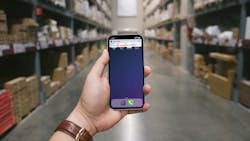What’s Next for Productivity? Mobilizing the Workforce
At a Glance:
- As more and more industrial enterprises design mobile-first strategies, the use of handheld devices, such as smartphones and tablets, are taking centerstage.
- Configured to fit the requirements of the job and the device policy of the organization, mobile applications can respect privacy while improving safety and productivity.
- Joe Boyle, CEO, Truce Software, helps companies become more flexible and resilient in the face of disruption and more mature in the post-pandemic era.
Tap. Scroll. Drag. Click.
After years of being piloted with varying degrees of success, the use of mobile technology in industrial settings is running at full tilt.
Much more than tools for providing remote access, the latest offerings in enterprise mobility tools signify not only a change in the way organizations manage production floors, but also the way they engage their employees.
When employers adopt mobile tech into their workflows, employees tend to perform better in their roles, improving productivity and efficiency, said Joe Boyle, CEO of Truce Software, a provider of contextually-aware mobile device management solutions.
According to a recent report, IDC FutureScape: Worldwide Digital Transformation 2021 Predictions, “digital first” dominates in every experience, with 60% of enterprises noting they will invest heavily in digitalizing employee experience in 2021. The effect will transform the relationship between employers and employees.
Planning ahead, companies will routinely need to consider the tools that support their workforce. With people returning to offices, said Boyle, enterprises have shifted to a new mentality that takes into consideration how to leverage technology to accomplish more and work faster with virtual teams.
“It opened up a world of possibility for people around the world to contribute to the working environment from wherever they are,” said Boyle.
Digital-first Mentality
Historically, mobile technology was designed to first serve the laptop or desktop computer user. But the current generation of mobile computing starts with the smartphone as the central form factor, noted Boyle, who has 20 years of experience building software-as-a-service (SaaS) and software business models.
The Lisle, Ill.-based Truce, which offers a contextually-aware mobile device management solution, essentially focuses on how workers and companies get the best out of mobile technology without succumbing to some of the downside risks. If used inappropriately, mobile devices can present liability issues associated with personal safety and data privacy and security, Boyle explained.
Truce focuses on harnessing the user’s context into the task of managing the acceptable and productive use of mobile technology in the workplace. “What’s going on around the device is as important as what’s happening on the device itself,” Boyle said.
“It takes a different set of technologies and processes to facilitate one’s work when one is away from the corporate facility and working remotely,” he explained. “COVID-19 and work-from-home realities have really opened everyone’s eyes to the unique challenges of doing work away from a corporate office.
“ It’s taken all of the executive teams and the traditional office-based staff and put them out into a proxy for what field-based workers live every day…and that’s leading to some really smart and effective investments in how companies support their mobile-first policies.”
Trust and Privacy
Whether enterprises provide company-issued devices or enforce BYOD (bring your own device) policies, secure access can be achieved when only applications relevant to the job function are installed and managed so that data remains protected for the organization and the employee.
The ability to control the permissions of a mobile device based on the context of the employee is a gamechanger, as it minimizes non-work-related distractions, improves productivity and provides a measure of protection, said Boyle.
Cybersecurity remains a primary concern in information systems infrastructure, and enterprises need to consider security measures (such as firewalls) along with managing the rights of active users.
At the same time, organizations need to be transparent about how they use information, Boyle noted. “At Truce, we’re a mobile-first environment, but privacy is an essential component of mobile first,” he said. As a solution provider, the firm subscribes to the ideal of being transparent.
Establishing trust is essential, emphasized Boyle, who said his company will neither gather, store or monetize data, nor will it provide insights into what enterprises are doing with their mobile devices.
“I do the majority of my work on [my iPhone] throughout the course of the day,” said Boyle. “This device also has all of my credit card information, and every photo that I’ve ever taken of my kids is on the device. While this is a work device, it is deeply personal to me. And that’s one of those shifts that has taken place.
“I have never felt personally connected to my computer or my laptop at work, but that’s not true for our mobile devices. So, that element of trust and privacy is absolutely essential for anything we do to deploy mobile devices in the workplace today.”
How Context Mobility Works
Contextual mobility management (CMM) software, which resides on an employee’s smartphone, identifies or senses pre-set zones—such as when the employee is driving, operating machinery on the plant floor or moving through a highly secure environment, as well as when the employee is outside of the work context. CMM recognizes the different aspects of each work environment, but also changes the user experience so they can operate their devices in a relevant, appropriate or safe context at any given time.
Truce Software works by identifying situational triggers and adapting what users can do on their device in the moment, explained Bruce. The company uses the mobile device’s network connections, which could include the IPS (indoor positioning system) and GPS (global positioning system) navigation, as well as geotagging, Wi-Fi access point triangulation, sensors, proprietary beacon technology and other emerging technologies to understand the context in relation to the user’s profile, the location and proximity of the mobile device.
A mobility server and its contextual logic engine is the foundational infrastructure in CMM deployment. It follows the user’s movements, determines the appropriate actions and populates a smart device with control information relative to the employee’s responsibilities at that location.A field operator who needs access to SCADA data, for example, may log into a plant and download maintenance histories and procedures, but may also have access to function controls that suppress alarms related to equipment repair. Only the functionality needed for the user’s role is presented on the screen. “It’s an intelligent, dynamic adaptation of the user experience,” said Boyle.
Emphasis on Employee Experience
Companies aiming for digital transformation (DX) examine every opportunity to modernize and improve current operations. But wholesale digital transformation requires a fundamental shift in thinking, and Boyle argued that embracing digital technology such as contextual mobile device management for all interactions and all processes is an essential component.
The use of mobile devices in workplaces is an underserved area in business operations, said Boyle, and its use will expand to more functions, particularly in the areas of wearables and to ensure worker safety in high-risk environments.
These mobility trends, combined with other IIoT trends (such as AI adoption, wireless connectivity options and automation), will continue to accelerate to create mobile working environments that are more productive and safer for those working on the shop floor or on remote sites. “I think that the pandemic has really opened people’s eyes to how we can better enable our workers with mobile technology,” said Boyle.
Digital design and innovation are undergoing a shift towards strongly considering the user experience, said Boyle. “At the end of the day, it’s always been about the people and how to give people what they need to get their job done.”
About the Author

Rehana Begg
Editor-in-Chief, Machine Design
As Machine Design’s content lead, Rehana Begg is tasked with elevating the voice of the design and multi-disciplinary engineer in the face of digital transformation and engineering innovation. Begg has more than 24 years of editorial experience and has spent the past decade in the trenches of industrial manufacturing, focusing on new technologies, manufacturing innovation and business. Her B2B career has taken her from corporate boardrooms to plant floors and underground mining stopes, covering everything from automation & IIoT, robotics, mechanical design and additive manufacturing to plant operations, maintenance, reliability and continuous improvement. Begg holds an MBA, a Master of Journalism degree, and a BA (Hons.) in Political Science. She is committed to lifelong learning and feeds her passion for innovation in publishing, transparent science and clear communication by attending relevant conferences and seminars/workshops.
Follow Rehana Begg via the following social media handles:
X: @rehanabegg
LinkedIn: @rehanabegg and @MachineDesign

